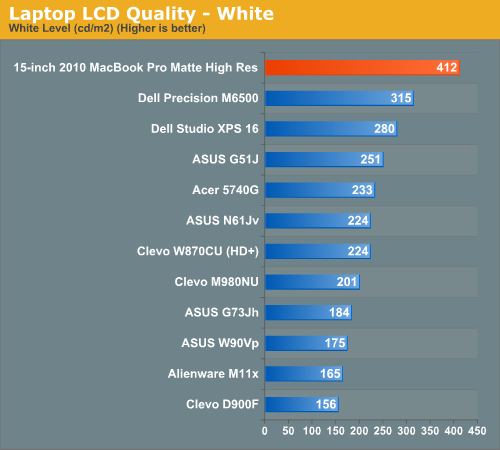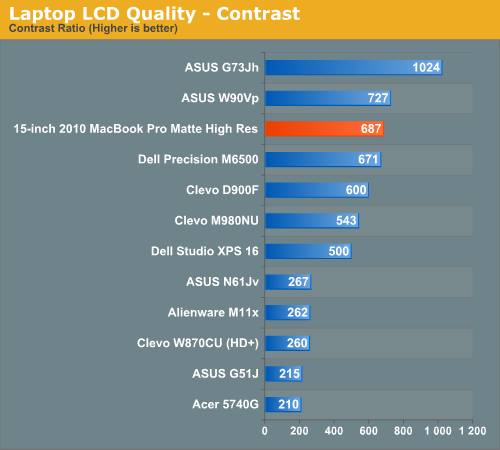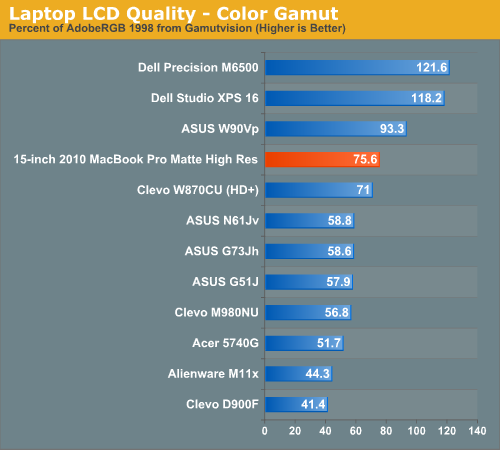Apple's 15-inch 2010 MacBook Pro: More Battery Life Tests, High Res Display Evaluated
by Anand Lal Shimpi on April 24, 2010 1:57 AM EST- Posted in
- Mac
- Displays
- MacBook Pro
- Arrandale
- Laptops
High Resolution, Matte Display: Tested
For creative professionals and digital photography or videography enthusiasts alike, LCD quality of the MacBook Pro is a huge consideration. Luckily, Apple delivers in this department.
Apple thankfully provides matte high resolution display options for both the 15” and 17” MacBook Pros. If you’re partial to glossy displays, there’s also a glossy high resolution display option available online, though it isn’t one of the SKUs that will be stocked in Apple retail stores - you’ll have to order it online.
Since many creative professionals likely will seek the matte option (and because it’s the only high resolution display option available in-store), we chose to do monitor profiling and analysis with this particular model. On the surface, very little has changed, the display itself still substitutes the black glass bezel for an aluminum one. The LCD sits inset from the aluminum bezel about a millimeter, diminishing the chances of your keyboard smudging and scratching up the display like what was so endemic with the pre-unibody design.
| 15-inch 2010 MacBook Pro 6,2 Core i7 | |||
|
Matte High Resolution Display Option
|
|||
| Panel Type | TN (Samsung LTN154MT07) | ||
| Pixel Pitch | 0.197mm | ||
| Viewable Size | 15.4 diagonal | ||
| Resolution | 1680 x 1050 (WSXGA+) | ||
| Screen Treatment | Matte (anti-glare) | ||
The first thing that strikes you about the 2010 MacBook Pro LCD is how bright it is. As we’ll show in a minute, it’s the brightest LCD we’ve tested, thanks in part to its WLED backlighting. While the color gamut is only above average, Delta E tracking is also very good.
For these tests, we used ColorEyes Display Pro with an X-Rite Eye-One Display 2 colorimeter. I originally tested at maximum brightness, and then at precisely 200 nits of luminance. The black level down below is given at maximum brightness. Interestingly enough, Delta E tracking and color accuracy remains largely the same at both settings.
Another note I’ll leave you with is that although using a calibration tool is still an absolute must for the best monitor performance, Apple’s display profile that ships with OS X is surprisingly good. Out of box, the display’s white point was almost exactly 6500K, and the LUT curves subjectively nearly matched those that eventually resulted after calibration. Color tracking and Delta E weren’t good, but subjectively the display looked good.





The LED backlight Apple uses in the display still isn’t RGB LED, so color gamut isn’t anything spectacular, but it isn’t bad either. Performance is average, but what we get is both expected and pretty good for this class of LED backlit notebook displays.


Display uniformity is very good; there is virtually no distracting light leakage from any of the displays. In addition, black level is very good throughout. The viewing angles remain largely what you’d expect from any TN panel in its class. There isn’t an overwhelming amount of color shift when viewing the monitor at horizontal angles. Vertical is another story - there’s a tight range of vertical angles over which the color shift is negligible.
The performance we get with the MacBook Pro’s display is very good - but it still could be better. Among WLED backlit, TN packing notebook LCDs, it certainly shines out as one of the best options. That said, there’s no reason this “Pro” notebook shouldn’t see RGB LED backlighting and potentially even an IPS panel as options soon. Enthusiasts and professionals are more than willing to shell out the cash for large gamut LCDs on the desktop - why not on the notebook? It’s obvious that Apple isn’t averse to IPS panels, especially considering the iPad.
















69 Comments
View All Comments
Brian Klug - Saturday, April 24, 2010 - link
Awesome tip! I didn't know you could do that!Output of running that:
LTN154MT07
Color LCD
Which appears to be a Samsung LCD of some kind, but doesn't have a datasheet on that website. Interesting. I'll update the article, thanks!
Cheers,
Brian Klug
Brian Klug - Saturday, April 24, 2010 - link
I also got that same error trying to post with the command; I think the CMS is escaping some characters in there and erroring out. ;)Thanks for bearing with it and posting that, I was going to resort to trying to pull that info out of some EDID tool from Windows and Boot Camp, but this is better.
-Brian
maxxl - Saturday, April 24, 2010 - link
You're welcome Brian :)Ah! I almost forgot… there's one more thing - apart of giving LCD model to you, running this little command gives me complete control over your new shiny MacBook Pro also ;) Just joking… enjoy! ;)
ppayne - Sunday, April 25, 2010 - link
Is it possible to give an idea of fan noise? I hate it and have generally been pleased with the 2009 15 inch laptop. I can hear the difference between running with discrete graphics on and with them off. Usually see 4000 when doing stuff with my laptop like Photoshopping or playing Plants vs. Zombies, though sometimes it goes way down to 2000 rpm. (I have a 160 gb Intel SSD installed.) Can you give an idea of fan RPMs when things are quiet and slightly loud?aj28 - Sunday, April 25, 2010 - link
Can't say how much quieter than the 2009, but it's a heck of a lot quieter than my 2008, and I kept that thing clean too! The dual fans make a world of difference. Maybe they're using a smaller glob of thermal paste too, compared to the huge mess they had been using...iwodo - Sunday, April 25, 2010 - link
It seems Glossy Screen has Black Edge around it while Matter is Aluminium colour....?Computer Scooter Joe - Sunday, April 25, 2010 - link
You are correct. The glossy screens have a panel of glass that covers the entire screen + bezel edge to edge. The bezel on these is black.On the matte option, the screen is recessed a tiny bit, and they get rid of the full glass covering, replacing the bezel with aluminium.
vailr - Sunday, April 25, 2010 - link
Could someone run Everest (in Windows) and see exactly which chipset is being used in these new MacBook Pros, and also include the similar Gulftown CPU desktop iMacs (if available)?P55 or PM55, H55, HM55, H57 and etc.
Thanks.
araczynski - Sunday, April 25, 2010 - link
a person peeve, but i hate it when companies call pretty much any device that can do 1280x800 or more "HD". Whenever I hear "HD" i expect 1080p minimum.i know, 720p IS "HD", so all displays that can fart anything close to that think they're HD too, but I think the name is used more to confuse consumers than anything.
araczynski - Sunday, April 25, 2010 - link
a person peeve, but i hate it when companies call pretty much any device that can do 1280x800 or more "HD". Whenever I hear "HD" i expect 1080p minimum.i know, 720p IS "HD", so all displays that can fart anything close to that think they're HD too, but I think the name is used more to confuse consumers than anything.
calling 1280x800 or even this 1650x1050 "HD" is a joke to me. like calling a bottom of the line minimally configured mustang a 'race car' just because it has the mustang name.